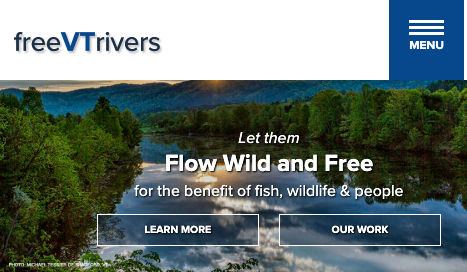The Vermont Natural Resources Council and The Nature Conservancy are pleased to announce the launch of “freevtrivers.org,” a website designed to educate the public about the benefits of removing so-called “deadbeat” dams – dams that no longer serve a public benefit – for fish, people and communities. Successful dam removal requires the collaboration of multiple partners and this site represents the work of American Rivers, Connecticut River Watershed Council, Vermont Council of Trout Unlimited, Lake Champlain International and others committed to re-connecting our rivers and streams.
“There are over 1,000 dams on Vermont’s waterways. Many of these are vestiges of an industrial era and no longer serve any purpose except to block fish passage, pose safety concerns, and compromise river habitat. We hope this new website will educate communities about the benefits of removing these derelict dams and provide a roadmap as well,” stated Heather Furman, Vermont State Director of The Nature Conservancy.
We estimate that there are hundreds of dams in Vermont that are considered “deadbeat.” Removing these dams will open up miles of previously obstructed fish habitat, improve flood resiliency and river health, and offer greater public access for recreation such as paddling and fishing.
“Nineteen dams have been removed in the past 20 years and we would like to see an acceleration of this effort. There are significant environmental and economic benefits to removing useless dams from our rivers. And in light of climate change and our state’s clean water goals, we’ll continue to make the removal of dams that serve no public benefit a statewide priority,” said Brian Shupe, Executive Director of the Vermont Natural Resources Council.
Currently, partners are working to remove the Sargent Osgood Roundy Dam on the White River in Randolph. Once this dam is eliminated over eighty-eight miles of river habitat will be free-running. The Nature Conservancy will be completing its ecological screening of all dams in the Champlain Valley watershed by the end of June and the results will be posted on the freevtrivers.org website once complete.




